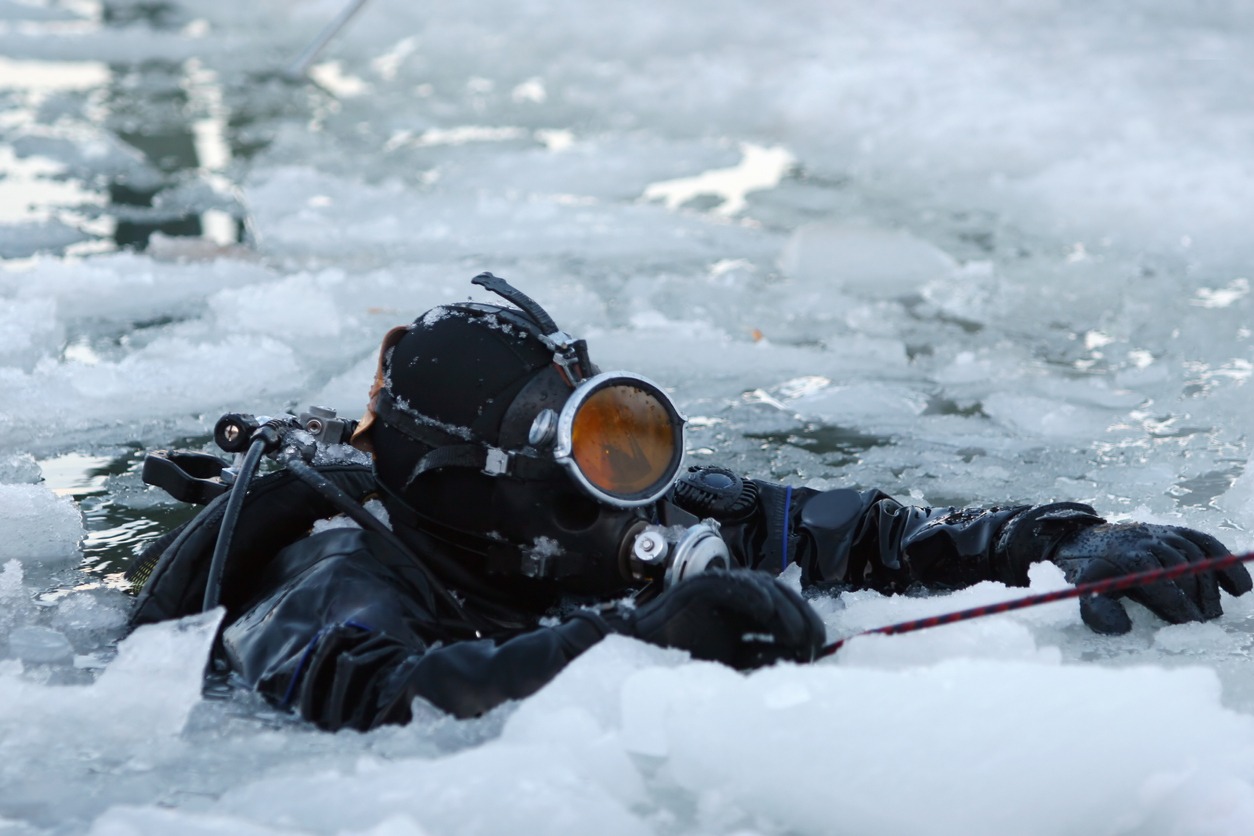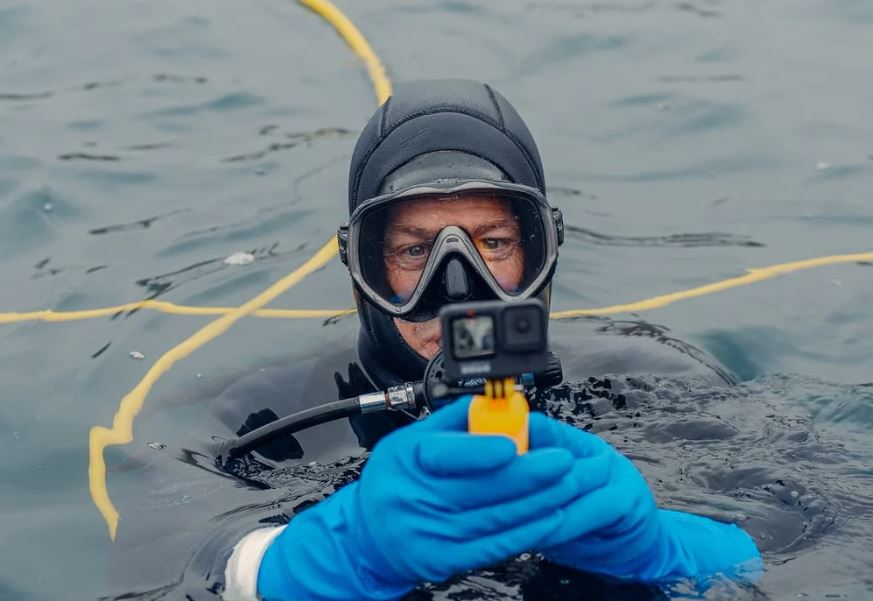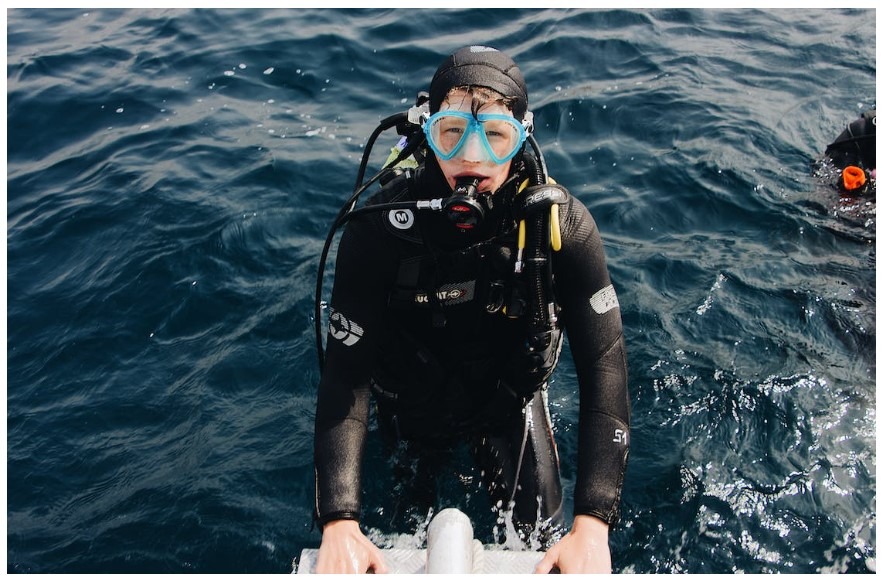Ice diving is penetration diving under ice. Ice diving requires special procedures and equipment due to the overhead environment and single entry/exit point. Ice diving is done for recreation, research, public safety (usually Search and Rescue or Rescue and Recovery), and other professional or commercial reasons.
Ice diving risks include getting lost, hypothermia, and frozen regulators. Safety-tethered scuba divers are common. This means the diver wears a harness to which a line is attached and monitored by an attendant. Surface-supplied equipment provides a tether, reduces the risk of regulator first stage freezing, and increases breathing gas supply. Freezing temperatures and thin ice are hazards for the surface support team.
Diver qualification
At least three divers are on the dive team. All divers must be:
- certified by the American Academy of Underwater Sciences (AAUS) and be part of the University of Alaska Dive Program or have a valid reciprocity card (certification to dive from AAUS or NOAA from a different organization)
- current on their medical exams, CPR, First Aid, and Oxygen Provider certifications
- have a lot of experience with dry suits and diving in cold water have been approved by the UA Dive Safety Officer and are registered as part of the dive team in the UA Dive Plan
- in good health and feel ready to dive
All of the equipment works well, and any that didn’t has been replaced (spares will be available). All of the diving equipment is packed in a way that makes it easy to get to the ice and move around on it (e.g., sleds). Tanks are filled with compressed air. You can’t use a mixture of gases. Once the ship is in place in the ice, dive sites are chosen. Most of the time, these dive sites are the edge of the ice, which is a safe distance behind the ship, or a hole or crack in the ice. The ship’s ice briefing is something that all divers take part in. Also talked about is the dive schedule for the day, such as buddy teams, the order of dives, tasks to be done, etc. Three divers and a tender make up the dive team. Two divers go into the water together as a buddy team. One diver stays at the surface and is ready to dive and help the other divers in case of an emergency. A tender takes care of the line that the divers are attached to. The line can’t be taken care of by the emergency diver. Here are the line signals, which can be given by either the divers or the tender and always get a response from the other end:
1 pull – ok
2 pulls (usually asked by divers) — give the boat more line
3 pulls (usually asked by divers) – take line in
Multiple quick pulls mean there’s an emergency and divers need to go up
What gear do you need to go ice diving?
Ice diving is a unique thing to do, and it takes unique gear to do it. Most scuba diving gear isn’t made for places as cold as this. To make gear that can handle ice diving, you need strong materials and a lot of engineering know-how.
Also, your diving gear should be as simple as possible. Just like with other kinds of penetration diving, you want to stay out of sight. Keep your gear close to you because you might have to work in a small space.
Here are some things to think about:
Ice Saw or Chainsaw
You’ll have to make a hole in the water to get in. That means you need to bring something with you to make a hole. Make sure you’ve been taught how to use a chainsaw on ice if you’re going to use one. Even if you’ve used a chainsaw before, it takes special skills to cut ice with one.
Cold Water Regulator
For ice diving, you need a regulator that is made to work in cold water. In contrast to the warm water regulator, the cold-water regulator has a “environmental seal” that doesn’t let water or other things into the regulator. This seal does a good job of keeping the regulator’s moving parts from getting frozen and breaking.
Diver Lights
When there is thick ice, the sun can’t get to the water. You’ll need a dive light if you’re going to dive in ice. It will help you enjoy your sightseeing more, but it’s also important for your safety.
Clothes that are warm for the surface
Your crew should wear warm clothes, and you should plan to change into something warmer when you get to the surface. After all, when it’s not your turn to dive, you’ll be in charge of someone else’s safety line. If the water is frozen, it’s cold enough that you don’t want to be outside in wet gear, even if it’s insulated.
Dry Suit
Dry suits are scuba suits that are made to keep water out. When ice diving, it can be important for comfort and safety to use a good dry suit instead of a wet suit.
Scuba Hood
A dry suit can help you stay warm and safe in cold water. But many dry suits still leave some skin on your head and hands exposed. Due to how cold the water is, an ice diver needs a thick, well-insulated hood.
It’s not true that your head is where half of your body heat goes. No other part of the body loses heat faster than the head. But when that myth first started to spread, it was because the scientists who were studying heat loss had everything on except their heads. If you don’t insulate any part of you, that part will quickly start to lose heat. This is why scuba divers in cold water need a hood so much.
Dive Gloves
If you’re going to dive in cold water, you need to keep as warm as possible. That means gloves and everything else. A good pair of dry gloves is important, but you’ll also need a way to keep your gloves in place, like a flex ring. Don’t forget to bring regular gloves for your turn on line watch.
Procedures for diving
With the help of the ship’s crew, gear is put on the ice. Divers put on their dry suits and bring their gear to the dive site that was agreed upon. Every diver puts their own gear together. The first buddy team puts on all of their gear and does a check with their partner. One of the divers is tied to the line that goes to the surface (50 m, of which only 30 m are fed out during a dive). The end of the tending line is tied to something heavy. Buddy lines connect the other diver to the first diver (4 m long). This set-up makes sure that divers stay close to each other but still have enough room to move around. If there were two independent buddy lines with two tenders, the lines for the tenders could cross, which would make it harder for the line signals to get through.
Divers go under water, and the tender will sometimes use line signals to ask the divers if everything is okay. Line is fed out for up to 30 m. How the ice is made determines how deep you can dive: Most level ice is less than 3 m thick, but ridge structures can go under water by several 10’s of m. Most of the time, the maximum dive depth is set at 20 m, unless a higher depth (up to 30 m) has been agreed upon because a special part of the ice needs to be sampled.
Divers are careful about how long they stay at the bottom, but most dives are so short that bottom time at these dive depths is not a problem. Dive time is mostly based on how cold it is, and it can be anywhere from 15 to 30 minutes. If a diver is uncomfortable (for example, if it’s too cold) or if something goes wrong with their equipment, the dive is cut short before the tasks are done.
Divers go back to where they got off the ice and get back on. After the divers take a short break to warm up and drink some water to stay hydrated, the second buddy team gets ready for a dive. This second buddy team is made up of the emergency diver and tender from the first team. Each dive team can go out twice, so a total of four dives can be done. Since dive depths are shallow and dive times are short, it’s not a problem to dive over and over again.
What to do in an emergency
An emergency happens when the ice becomes dangerous (ice breaks, ship needs to move, polar bear shows up, etc.) or when a diver has trouble under the water. In the first case, the emergency line signal will be used to call divers back to the surface (multiple rapid pulls). The divers respond to the line signal to show that they understood the emergency, stop all sampling right away, and quickly but safely head back to the entry point.
There, the tender and emergency diver help them quickly get onto the ice. If the divers don’t respond to the line signals sent by the tender, that’s also an emergency. In this case, the emergency diver quickly jumps into the water and follows the tending line to the divers. Once there, he or she can help the divers safely climb out of the water and get back to the entry point.
In case of an emergency, the extra scientists on the ice can be called upon to help. For example, AAUS rules say that the tender does not have to be a certified diver. This means that if there is an emergency, another scientist can help with the tasks on the ice. The ship’s doctor is the person to call in case of a medical emergency.
Conclusion
Ice diving is not like your typical scuba dive in any way. It enables you to see animals that the vast majority of people are unable to see and brings you closer to them than they normally allow. It provides excellent lighting conditions for photographers as well as opportunities to interact with the surrounding environment in novel ways.
It is necessary to have specialized care, training, and equipment in order to accomplish it. However, once you’ve gotten the hang of things, the scenery is absolutely breathtaking. There will be clear water, penguins, and more waiting for you.



